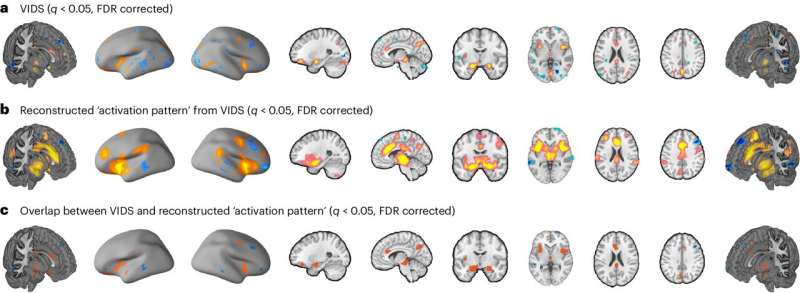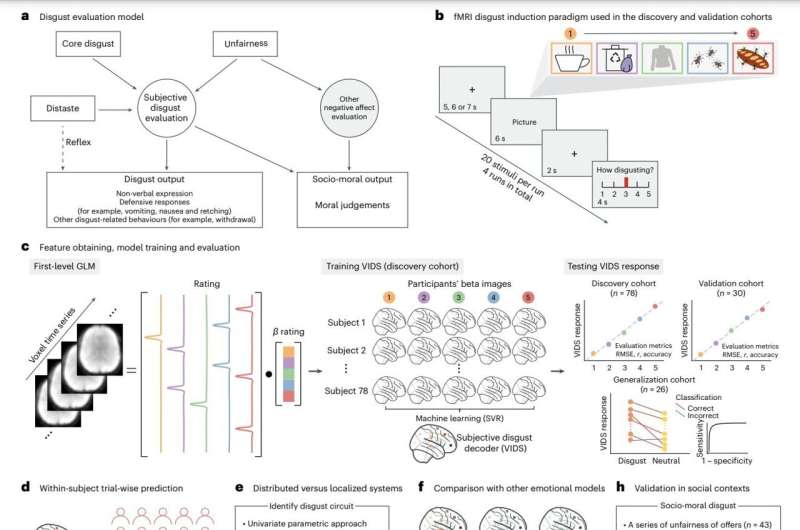May 17, 2024 feature
This article has been reviewed according to Science X's editorial process and policies. Editors have highlighted the following attributes while ensuring the content's credibility:
fact-checked
peer-reviewed publication
trusted source
proofread
The neural signature of subjective disgust could apply to both sensory and socio-moral experiences

Disgust is one of the six basic human emotions, along with happiness, sadness, fear, anger, and surprise. Disgust typically arises when a person perceives a sensory stimulus or situation as revolting, off-putting, or unpleasant in other ways.
Past psychological studies have defined disgust as an avoidant-defensive emotion, linking it to specific facial expressions, movements, and physiological responses. While it is predominantly associated with tasting unpleasant food, smelling foul odors or seeing revolting images, it can also arise in response to other stimuli, including unpleasant experiences during social interactions.
Researchers at University of Electronic Science and Technology of China and other institutes recently carried out a study aimed at better understanding the neural underpinnings of disgust and its generalization across contexts beyond eating. Their findings, published in Nature Human Behaviour, suggest that the neurofunctional signature of subjective disgust is the same for oral distaste and unpleasant socio-moral experiences.
"While disgust originates in the hard-wired mammalian distaste response, the conscious experience of disgust in humans strongly depends on subjective appraisal and may even extend to socio-moral contexts," Xianyang Gan, Feng Zhou, and their colleagues wrote in their paper.
"In a series of studies, we combined functional magnetic resonance imaging (fMRI) with machine-learning-based predictive modeling to establish a comprehensive neurobiological model of subjective disgust."

People who participated in the team's experiment were shown different images designed to elicit feelings of disgust and were asked to naturally respond to these images. After seeing each image, participants were asked to rate their level of disgust on a scale from 1 (little/no disgust) to 5 (strong disgust).
By monitoring the brain activity of participants using fMRI technology and analyzing collected data using a machine learning model, the researchers were able to outline a whole-brain neural signature associated with subjective perceptions of disgust. This signature was found to accurately predict self-reported experiences of disgust among study participants, generalizing well across basic disgust, taste-related distaste, and social-moral responses to unfair offers during a game.
"Disgust experience was encoded in distributed cortical and subcortical systems and exhibited distinct and shared neural representations with subjective fear or negative affect in interoceptive-emotional awareness and conscious appraisal systems, while the signatures most accurately predicted the respective target experience," Gan, Zhou and their colleagues wrote in their paper.
"We provide an accurate functional magnetic resonance imaging signature for disgust with a high potential to resolve ongoing evolutionary debates."
The recent study by Gan, Zhou and their collaborators delineates a pattern of activity across the whole brain associated with subjective disgust experiences. Specifically, subjective disgust was found to be simultaneously encoded in various brain regions across the brain, rather than in individual brain regions.
Interestingly, the researchers observed the same brain-wide neural signature in different situations where people experience disgust, ranging from tasting unpleasant foods to feeling empathy for other people who are in pain or receiving an unfair offer. These results could soon pave the way for further neuroscientific studies focusing on the reported neurofunctional signature of disgust, potentially leading to new fascinating discoveries.
More information: Xianyang Gan et al, A neurofunctional signature of subjective disgust generalizes to oral distaste and socio-moral contexts, Nature Human Behaviour (2024). DOI: 10.1038/s41562-024-01868-x
© 2024 Science X Network



















